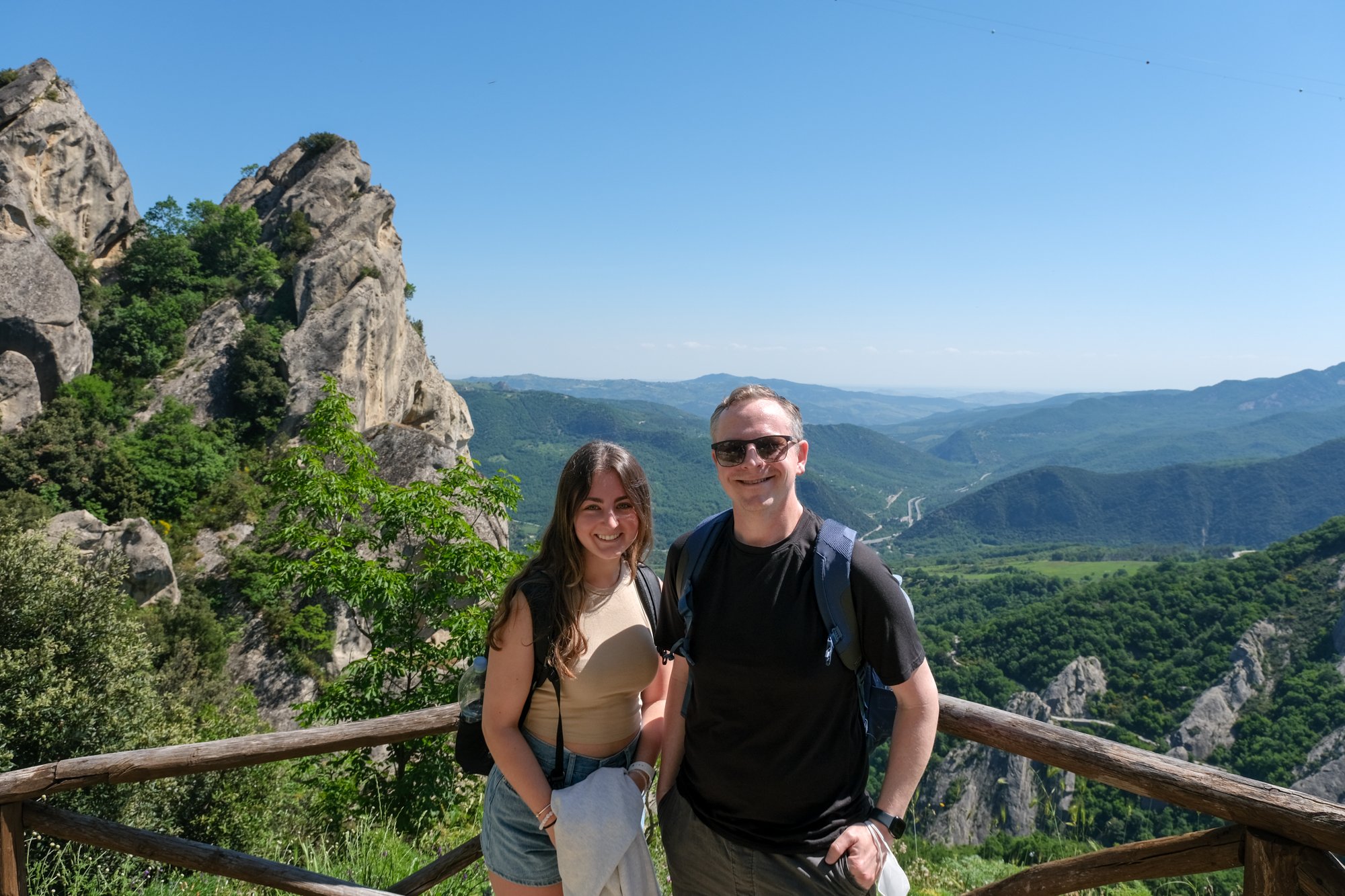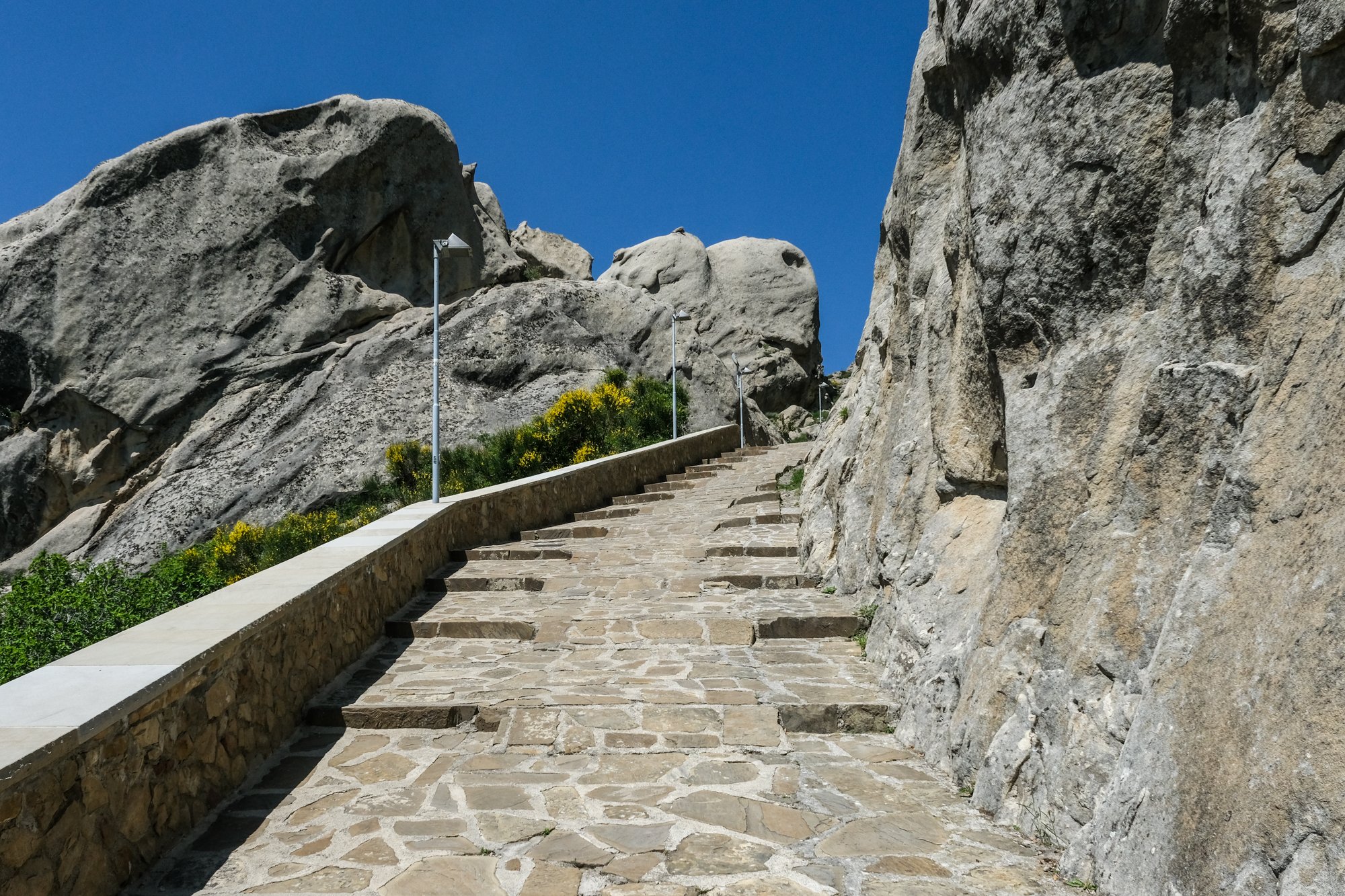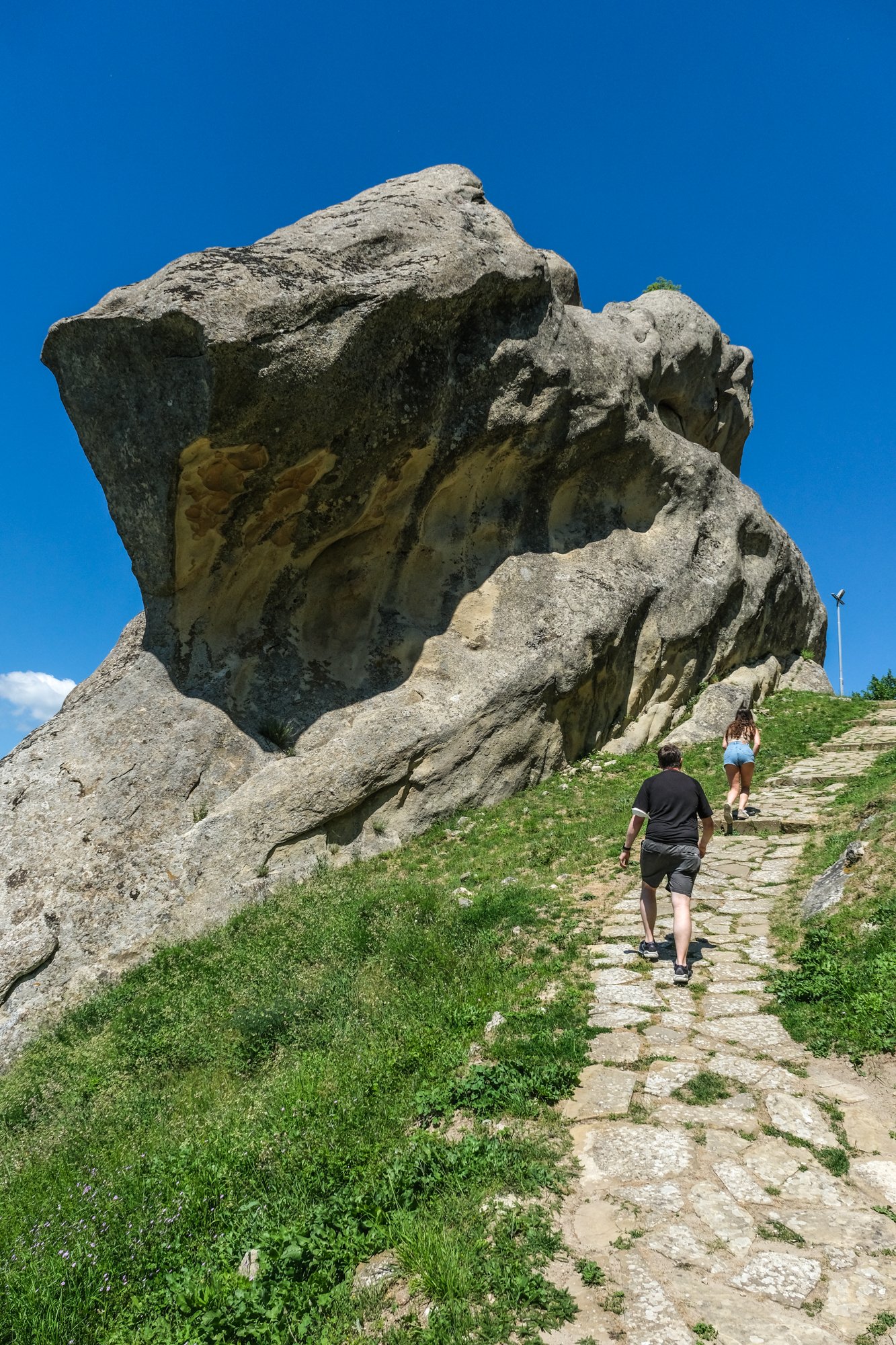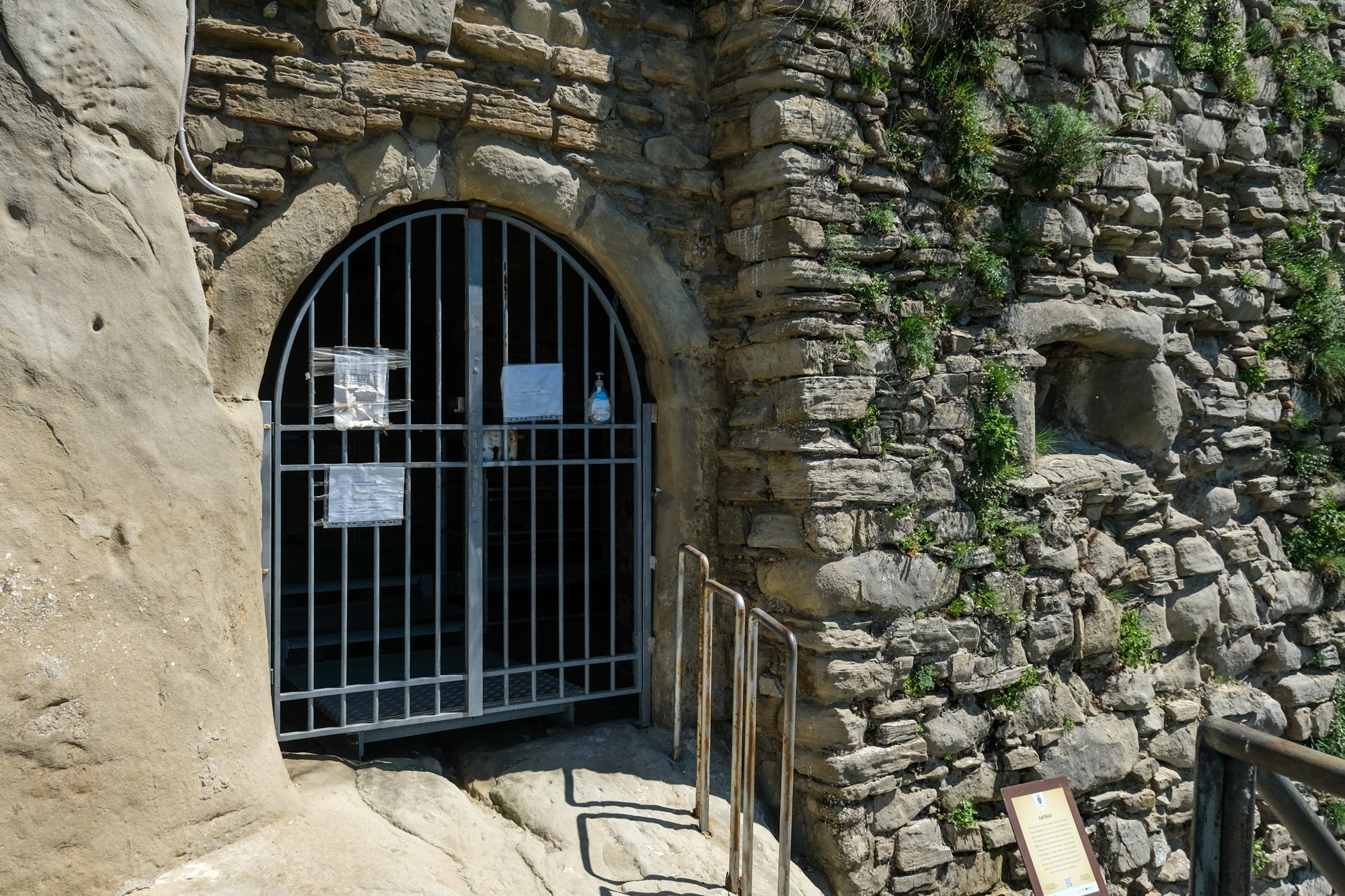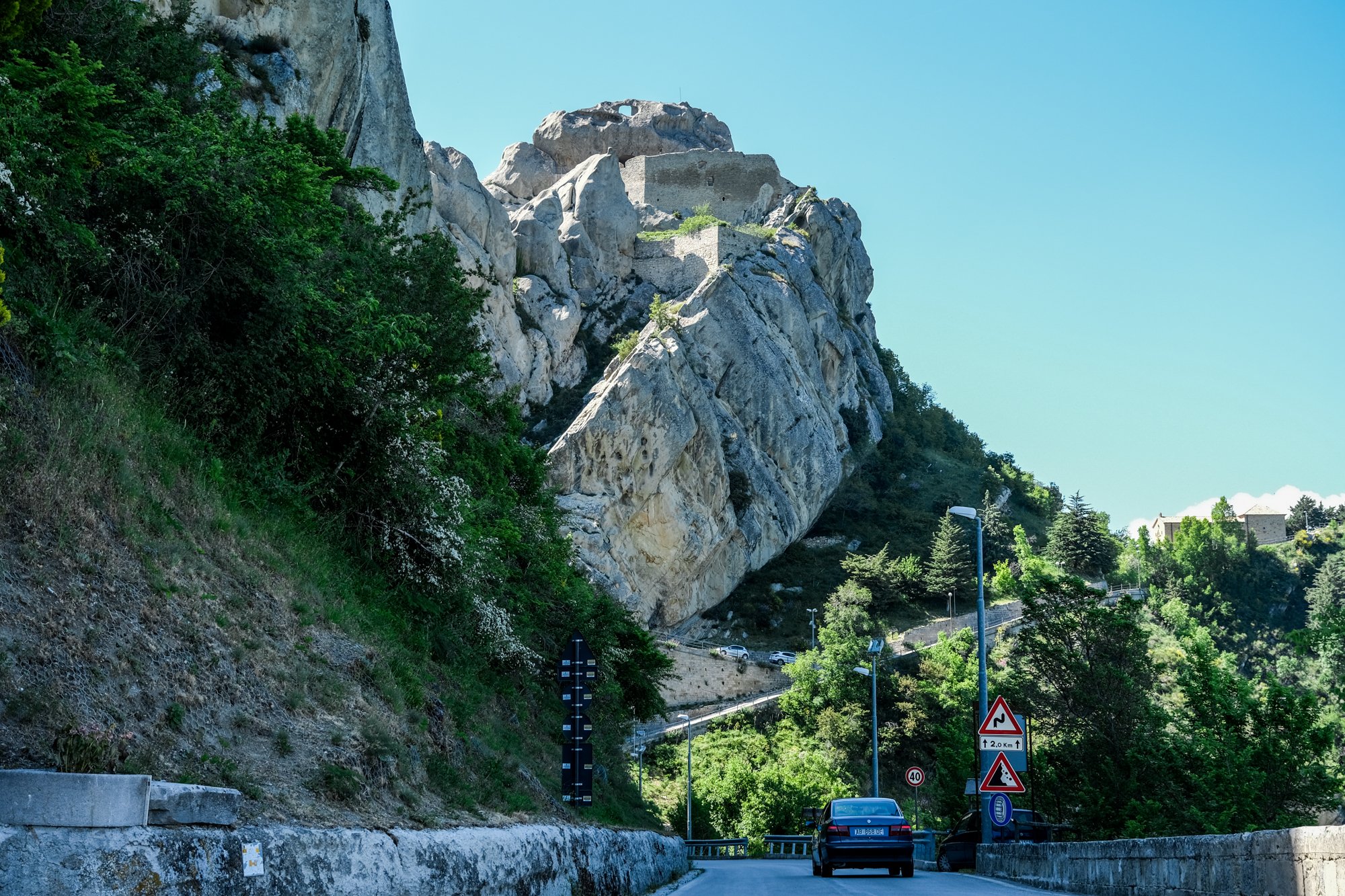The Small But Mighty Dolomiti Lucane
For various reasons, we decided to fly in and out of Rome’s Fiumicino Airport for our recent trip to Puglia. In hindsight, flying in from Naples may be a more sensible choice. Instead, it was a four-hour drive to cover the distance between Rome and Naples. After a lunch stop at Castel Gandolfo, we got on the Autostrade. Brian and I underestimated how miserable and boring the driving experience was. It had none of the charms of Italy, and we had a couple of stressful moments at their automated toll booths. Who knows if driving with severe jet lag would be so stressful?! We ended up having to take turns driving to stay awake.
I had difficulty figuring out exactly where we should stay for the first night of the trip. For quite a while, I thought about staying in Caserta, a northern suburb of Naples. I thought visiting the impressive Royal Palace of Caserta (Reggia di Caserta) might make a good impression on our niece Mary. My only hesitation was the lack of affordable or quality accommodations in town. I also wondered whether we would be up for intense sightseeing on the first day.
Just when I was about to book the hotel for Caserta, I came across an image of a picturesque town called Castelmezzano while researching the trip by serendipity. Set on the slope of a craggy peak, it is unlike any hill town I have ever seen. I was immediately hooked. But the strangest thing was that there wasn’t much information about this place online. Given that Italy is Europe's most popular travel destination, why aren’t more people talking about this awe-inspiring place? There must be a reason this place has not been on the tourist trail, right? I was determined to find it out ourselves.
Castelmezzano
Although I couldn’t find much English information online, I was pleased to see plenty of accommodation options in Castelmezzano. It did reassure me that this place is not completely off the beaten track. After all, I don’t want to bring Mary to an abandoned village for her first night abroad. As soon as we got off the Autostrade, we felt like we could finally appreciate the natural beauty of this country. By this point of the day, we were all exhausted and ready for a hot shower. To maximize the element of surprise, I opted not to show Brian and Mary the picture of the town ahead of time. I wanted this to be a little of a surprise. I was confident that the sheer beauty of this place would gobsmack them.
As soon as we exited the final tunnel, the dramatic village appeared on the horizon. No matter how many pictures you have seen, it still does not prepare me for the beauty of Castelmezzano. The town's perspective was even more dramatic than what pictures could convey. It was about 7 pm when we arrived in the center of town. Most of the village was already under the shadow of the surrounding mountain, but the outcropping backdrop was still beautifully illuminated by the setting sun. Of course, the photographer within me secretly regretted not getting here an hour earlier. I may have just missed the perfect shot.
I booked a massive two-bedroom apartment overlooking the valley below for the night. Following the host’s instructions, I drove inside the town’s ZTL zone to drop Mary, Brian, and the luggage at the town’s main piazza. The pizza also happened to be a belvedere that offers the most classic panorama of Castelmezzano. All of us were awestruck by this place's sheer beauty and drama. But for me, what worried me the most was getting out of the ZTL zone before the police showed up. I would hate to get a ticket on my first day in Italy. But truthfully, it is more likely that we would get a ticket through the rental agency months afterward if we got caught.
Like most hill towns, Castelmezzano has a great shortage of parking spaces for non-residents. Although I did find a parking spot not too far from the village, navigating their automated parking machine was another matter. It is no surprise that my American credit card did not work there, but I am surprised that the other way to pay for the €7 overnight parking fee was using €1 coins. Well, who carries about that many €1 coins? Ultimately, I paid what I could and finger-crossed that I could get more coins later in the evening.
Navigating the streets of Castelmezzano was a thrilling experience. Even with an address, locating the apartment without our host showing us the way was quite a challenge. Since Brian and Mary checked into the place before me, I was at a loss and had to wait for Brian to meet me at the piazza. Unlike the hill towns of Umbria, the passageway here is far more hilly and picturesque. Views of the dramatic landscape appear and disappear now and again. I could hardly think of a more magical place.
Because we were exhausted, we were keen to go for an early dinner and get to bed. Following the advice of the apartment host, we had our dinner at what was supposedly the best restaurant in town: Restaurant Al Becco della Civetta. The restaurant specializes in Lucanian cuisine, the native cuisine of this region, Basilicata. I would be the first to admit that I knew little of Basilicata, let alone its food tradition. Given our own ignorance, we ordered their Lucanian antipasti sampler, which contains their local goat cheese and charcuterie. But the star on the plate got to be the dried red pepper. Known as pepperoni cusco, these mild-flavored peppers are the most well-known component of Lucanian food tradition and earned the nickname of the “red gold of Basilicata.”
Because Italians are not particularly known for their spicy food, I was suspicious of how good these peppers could be. To my surprise, there is hardly any spicy note. Instead, it is very fragrant and super crunchy, which makes them a perfect snack. I am surprised that the scouts from Trader Joe’s haven’t discovered this and exported it back to America. It was a good thing that I loved peperone crusco, because the Primi dish I ordered was topped with them. The dish Strascinati EXPO represented Basilica at Expo 2015 in Milan! It may not be the most amazing pasta dish I had in Italy, but I was glad to say it expanded my understanding of Italian food.
After a restful night of sleep, I woke up refreshed and ready to explore Castelmezzano more deeply. Luckily, we still had beautiful weather, and the town looked even more magnificent than the day before. Castelmezzano is not a big village, but it could feel like a workout to get from one side of the village to the other. With so many narrow and steep lanes, the locals seem to be getting around by miniature tractors or buggies. But with so many staircases, you must be of reasonable fitness to call this place home. Being in a place like Castelmezzano, one can’t help wondering why the early settlers called this place home. Far from any major body of water and inaccessible, this seems like the last place you would want to build a village.
I have traveled wide enough to know that settlements like Castelmezzano’s precarious geography are often a product of necessity born out of a turbulent past. In the case of Castelmezzano, the surrounding region of Lucania has long been passed along between various powers of the Mediterranean world. The 10th century saw the turn of the Saracen, a catch-all term for the Muslim invaders. Terrified, the locals sought to relocate their town to a more defensible position. According to the legend, a shepherd named Paolino found the craggy peaks nearby ideal for repelling the enemies. The steep slopes allow the residents to repel the invaders by rolling down boulders from their town.
During the Lombards' rule, a castle was constructed to be the main lookout point of the region. The name Castelmezzano means “Castle of the Middle.” The “middle” here refers to Castelmezzano’s position between the nearby hill town of Pietrapertosa and Albano di Lucania. Even after the Muslim occupiers were repelled from the Italian peninsula, the town remains a place of refuge. Ironically, in the 19th century, Castelmezzano became a popular hiding place for roving bandits that ran amok in this part of Italy. `
For visitors like ourselves, Castelmezzano is pretty light on architectural or historical monuments. Besides the Church of Santa Maria of the Elm, the main attraction here is the natural wonder of the surrounding mountain range. Known as Dolomiti Lucane, this mountain range has a striking visual resemblance to the famous Domolite mountain range in northern Italy. The craggy peaks shaped by karstic erosion may not be massive but are nothing short of being theatrical. Most visitors to Castelmezzano were drawn here by its bountiful hiking trails and adventure activities. All around the town, there were posters advertising mountain bikes and ATV tours.
Following the peaks, we headed eastward until we came into a narrow lane following the side of a massive boulder. The juxtaposition between the stone monolith and humble houses is particularly sublime. The sloth within me admires whoever lives here; it was a solid ten-minute trek from the main piazza. After a short hike, we arrived at a platform overlooking the splendid Dolomiti Lucane. The expanded vista is breathtaking and is quite different from the view from the center of town.
Norman’s Steps (Gradinata Normanna) is the most famous natural feature in Castelmezzano. The beautiful monolith has 54 steps carved in and is believed to be the access to a watch tower of a medieval castle. You may think that 54 steps might not sound bad, but considering the tight treads and absence of handrails, it is not an activity for everyone with slight acrophobia. Access is only allowed via a pre-arranged tour with a licensed guide. Unfortunately, there was no appointment that day since we were here before the high season. But for anyone curious about the view from the top, check out this beautifully produced drone footage. This would be a must-do activity in Castelmezzano and worth booking ahead.
Regarding worthwhile activities, Castelmezzano’s best-known attraction is two zip lines connecting Castelmezzano with the nearby town of Pietrapertosa. Known as “Flight of the Angels” (il Volo dell’Angelo), the two zip lines are nearly a mile in length each and have a top speed of up to 75 miles an hour. It is among Italy's tallest and arguably most scenic zip lines. The local town councils set up this project for economic development. By all accounts, the project is very successful and puts the town on the tourist trail. For €35 a head, this is the most worthwhile experience I could think of. Unfortunately, they only operate the zip line once a week during the month of May, and we happened to miss it by just one day.
Surprisingly, Mary was very open to the idea. We had no idea that she would be such a daredevil. Besides the zip lines, the town offers trekking routes of various lengths and difficulties. One route actually connects the two towns, just like the zip lines. Naively, we thought perhaps we might be able to hike there in just an hour or two. After all, how long could it take to cover a mile on foot? Given the wonderful weather, all three of us were very keen on the adventure until we discovered that a safety harness would be necessary for much of the trek. I guess that is just another reason why a return visit is warranted!
With Matera being our destination for the day, we had a couple of hours extra. Since we did get to Pietrapertosa by zip-line or hiking, we could always drive there, right? From Castelmezzano, we could see Pietrapertosa from a distance; it looked like a falcon resting high above the cliff, calling us for a visit. Even though the two towns were only a mile apart, it took us more than thirty minutes to drive there due to road closure and bad directions from Google. As we drove away from Castelmezzano, I could not help but feel a bit of melancholy; it is one of those towns I would never forget.
Pietrapertosa
When people describe twinning towns, I could think of no better example than that of Pietrapertosa and Castelmezzano. Unbeknown to me until much later, both towns are part of “The Most Beautiful Villages In Italy” (I borghi più belli d'Italia) program promoting preserving the country’s best small towns. Even though it is a private organization, the program reminds me of the Pueblos Mágicos program in Mexico. I am unsure how the program works or whether it is well-publicized, but the list comes in handy with trip planning.
Compared to Castelmezzano, Pietrapertosa is set along a more gentle slope; it feels more open and less foreboding. As we arrived at one of the paid parking lots along the ridge, it was a gentle ten-minute stroll toward the center of town. The town seems considerably larger and more economically successful. There are even a few modern apartment blocks and plenty of shops and restaurants. While domestic tourism still plays an important role in the local economy, there was a spirit of great vitality here, judging by the number of vehicles, bikes, and pedestrians on the streets.
It was not before long until the full glory of Pietrapertosa presented itself. The village shares a similar history as its cousin across the valley. In the late 19th century, both towns suffered from depopulation, particularly from emigration to America. Seeing how these towns revitalized themselves from the brink of demise is heartwarming. As far as I could tell, there was not a single abandoned home in town, and it is as pretty and pristine as great hill towns such as Orvieto or Civita di Bagnoregio.
For lunch, we stopped at the lovely La Locanda di Pietra to sample more culinary delights of Lucania. We had a tranquil view of the nearby Church of Saint James the Major from the lovely terrace. This being our first leisurely lunch on this trip, the meal took about 90 minutes from start to finish. We also got to share some of Italy’s unique dining culture with Mary. I also had my first of many plates of orecchiette in Italy and my new favorite, peperone crusco. I mistakenly called it “pepper crunchies” when I came to order. Thankfully, the waiter did not bat an eye and saved me the embarrassment.
After lunch, we braced the heat and blazing sun to explore Pietrapertosa’s most famous site: the Norman Castle (Castello Normanno). Located at the northern edge of the town, the castle is the town's highest point and dates back to the early 11th century. From the main part of town, it was a strenuous 10-minute walk up the steep path. At 30 degrees incline, climbing was honestly hard work and probably not the best thing to do after a big meal. And despite the superb weather, there was not another soul in sight; perhaps only foreigners like ourselves are naive enough to venture out this time of the day.
Despite the blazing sun and heat, the hike itself was extremely rewarding. The path weaves through various dramatic monoliths, almost like we were on a pilgrimage. As we trekked higher, the full range of Dolomiti Lucane came into view. Eventually, Castelmezzano came into view. We can appreciate its unique geological features from this area. It was not until much later that I learned this is where the Mediterranean and African plates collided. The southern region of Puglia was once connected to present-day Tunisia and Libya. With that knowledge, the geological strata of these peaks take on special significance.
It doesn’t take a genius to see why the Normans built their castle here. According to the signpost, there have been defensive structures since before Roman times. The ancient settlers would carve inhibit the natural caves and carve out new ones to provide the ideal hideout places for the enemy. Looking up at the tower, I could only imagine the dread of any enemy forces trying to storm the castle. Unfortunately, we did not plan our day out well. Like everything else here, it was closed for the day. While the closure was disappointing, the vista from the castle gate is worth the hike.
On our way down, we came across an abandoned pully system constructed to renovate the castle. Further down, we came across the actual launching platform for the "Flight of the Angels.” It looks as scary and thrilling as we imagined it to be. We could get a good preview of the zip line from the platform to Castelmezzano. I wonder whether they offer additional drone footage services for their participants. That could be one of the coolest souvenirs in the world!
Since almonst everything in town was closed for siesta, we opted to head out toward Matera. It was eerie how the town’s life vanished in just an hour. For architectural photographers, this would be a dream come true. While the town was devoid of life, I noticed many more details I had missed on the way into town. One of my favorites would be the bunches of peperone crusco hanging by the side of a private home. Although I also saw some similar hangings in Matera the following day, they did not have that same “feel of authenticity” there.
Even though our visit had been short, I somehow felt a rather deep connection with this place. Castelmezzano and Pietrapertosa embody what Rick Steves would probably call the “backdoor” of Italy. Mostly, these two towns stay off the international tourist trail and choose to develop their tourism with sustainability in mind. Visitors are cared for but not necessarily catered to. Due to their relatively remote locations, I expect they could retain their historic characters and authenticity even in the age of Instagram.
























